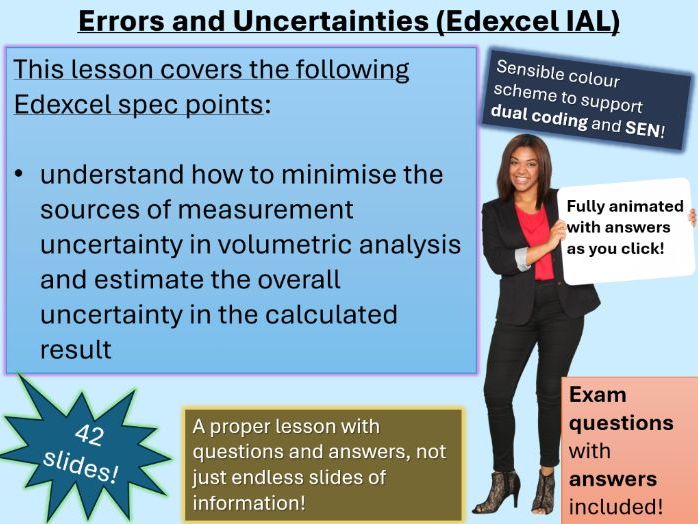


What is a systematic error and random error? What is propagation of uncertainty? How many significant figures for relative uncertainty? All this and more covered in this comprehensive lesson with questions and answers! This is a Year 12 A level lesson for Edexcel International Unit 2 – WCH12, but it can also be used for all UK exam boards. All the slides in this lesson are fully animated and include answers to every mini plenary question and exam question. The breakdown of the slides (which are best opened on Microsoft PowerPoint) is as follows:
Slide 1 - Title and 5-minute starter. The starter is a grid of four questions entitled ‘last week, last lesson, today’s learning and future learning’. Use this generic slide for all of your lessons by simply changing the questions and the answers each time.
Slide 2 - Lesson objectives (see thumbnail image)
Slides 3 – 4: This is a starter question to test students on their ability to quote decimal places and significant figures when performing calculations
Slide 5 - Random errors, what they are, how they can be reduced and examples of random errors in experiments
Slide 6 - Systematic errors, what they are, how they can be reduced and examples of random errors in experiments
Slides 7 – 10: A word fill exercise including a word bank to test students understanding of systematic and random errors
Slide 11 - Introduces the concept of uncertainty
Slide 12 - The first example of instrument uncertainty is presented on this slide using a burette. Although the uncertainty is +/-0.05 centimetre cubed, students are taught that the uncertainty is +/-0.1 because the burette is read twice for each titre
Slides 13 - 16: students are introduced to absolute uncertainty using the example of a mass balance
Slides 17 - 20: learning pit-stop to check students’ learning. A series of questions of increasing difficulty, with the stretch and challenge (S+C) being the hardest. Answers animate onto the screen when you click
Slides 21 - 27: students are introduced to the concept of relative and percentage uncertainties, with the help of three worked examples with working out which animates on the screen when you click.
Slides 28-33: this section covers propagation of uncertainties and goes through two worked examples of propagation using absolute uncertainties and propagation using relative uncertainties. All the working out is included with the resource and animates onto the screen as you click
Slide 34: how can the relative uncertainty associated with the measurement be decreased? This question is answered on this slide
Slides 35 – 42: Exam questions with mark scheme answers (included with the purchase of this resource)
Something went wrong, please try again later.
I am just copying and pasting the same review because i bought the bundle. i wanted to write an individual comment for each resource, but it was taking too long. top quality throughout, thank you!
to let us know if it violates our terms and conditions.
Our customer service team will review your report and will be in touch.